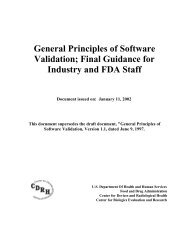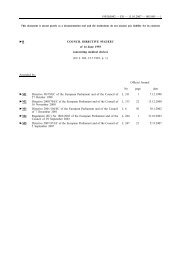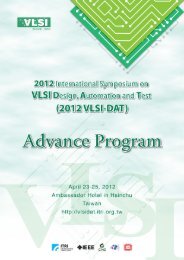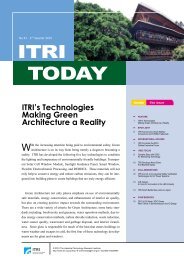Design Control Guidance - Food and Drug Administration
Design Control Guidance - Food and Drug Administration
Design Control Guidance - Food and Drug Administration
You also want an ePaper? Increase the reach of your titles
YUMPU automatically turns print PDFs into web optimized ePapers that Google loves.
• Implementation of corrective actionsEvaluation of the design. Many formal design reviews take the form of a meeting. At thismeeting, the designer(s) may make presentations to explain the design implementation,<strong>and</strong> persons responsible for verification activities may present their findings to thereviewers. Reviewers may ask for clarification or additional information on any topic, <strong>and</strong>add their concerns to any raised by the presenters. This portion of the review is focused onfinding problems, not resolving them.There are many approaches to conducting design review meetings. In simple cases, thetechnical assessor <strong>and</strong> reviewer may be the same person, often a project manager orengineering supervisor, <strong>and</strong> the review meeting is a simple affair in the manager’s office.For more elaborate reviews, detailed written procedures are desirable to ensure that allpertinent topics are discussed, conclusions accurately recorded, <strong>and</strong> action itemsdocumented <strong>and</strong> tracked.There is a dangerous tendency for design review meetings to become adversarial affairs.The reputation of the designers tends to be linked to the number of discrepancies found,causing the designers to become defensive, while the reviewers score points by findingweaknesses in the design. The resulting contest can be counterproductive. An addedcomplication is the presence of invited guests, often clinicians, who are expected toprovide the user perspective. These reviewers are often very reluctant to ask probingquestions, especially if they sense that they may become involved in a conflict where allthe rules <strong>and</strong> relationships are not evident.These difficulties can be avoided by stating the goals <strong>and</strong> ground rules for conducting theformal design review clearly at the outset. While the designers are in the best position toexplain the best features of the design, they are also most likely to be aware of the design’sweaknesses. If the designers <strong>and</strong> reviewers are encouraged to work together tosystematically explore problems <strong>and</strong> find solutions, the resultant design will be improved<strong>and</strong> all parties will benefit from the process. Participants must be encouraged to askquestions, avoid making assumptions, <strong>and</strong> think critically. The focus must be on thedesign, not the participants.Not all formal design reviews involve meetings. For extremely simple designs or designchanges, it may be appropriate to specify a procedure in which review materials aredistributed or circulated among the reviewers for independent assessment <strong>and</strong> approval.However, such a procedure negates the benefits of synergy <strong>and</strong> teamwork, <strong>and</strong> should beconsidered only in cases where the design issues are limited in scope <strong>and</strong> well defined.Resolution of concerns. The reviewers consider concerns raised during the evaluationportion of the formal design review <strong>and</strong> decide on an appropriate disposition for each one.There is wide variation in the way companies implement decision-making processes. Insome cases, the reviewers play an advisory role to the engineering manager or othercompany official, who directs the formal design review <strong>and</strong> ultimately selects a course ofSection E. <strong>Design</strong> Review 3/11/97 Page 27
















